Heinrich J.G., Aldinger F. (Eds.) Ceramic Materials and Components for Engines
Подождите немного. Документ загружается.

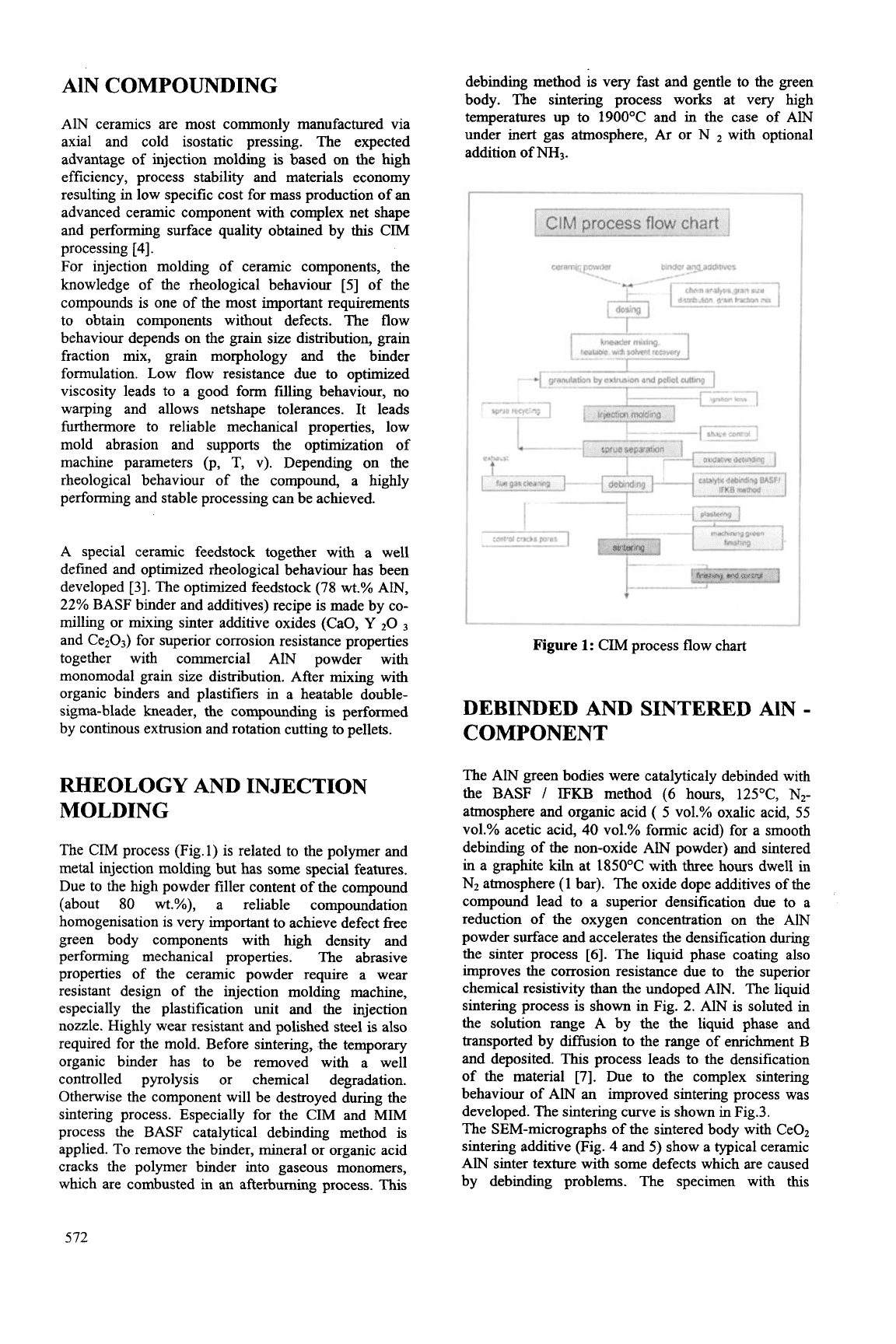
AlN COMPOUNDING
A1N ceramics are most commonly manufactured via
axial and cold isostatic pressing. The expected
advantage of injection molding
is
based on the high
efficiency, process stability and materials economy
resulting in low specific cost for mass production of an
advanced ceramic component with complex net shape
and performing surface quality obtained by
this
CIM
processing
[4].
For injection molding of ceramic components, the
knowledge of the rheological behaviour
[5]
of the
compounds is one of the most important requirements
to obtain components without defects. The flow
behaviour depends on the grain size distribution, grain
fraction mix, grain morphology and the binder
formulation. Low flow resistance due to optimized
viscosity leads to a good form filling behaviour,
no
warping and allows netshape tolerances. It leads
furthermore to reliable mechanical properties, low
mold abrasion and supports the optimization of
machine parameters (p,
T,
v). Depending on the
rheological behaviour of the compound, a highly
performing and stable processing can be achieved.
A special ceramic feedstock together with a well
defined and optimized rheological behaviour has been
developed [3]. The optimized feedstock (78
wt.%
AlN,
22%
BASF binder and additives) recipe is made by co-
milling or mixing sinter additive oxides (CaO,
Y
20
and Ce203) for superior corrosion resistance properties
together with commercial AlN powder with
monomodal grain size distribution. After mixing with
organic binders and plastifiers in a heatable double-
sigma-blade header, the compounding is performed
by continous extrusion and rotation cutting to pellets.
RHEOLOGY AND INJECTION
MOLDING
The CIM process (Fig.1) is related to the polymer and
metal injection molding but has some special features.
Due to the high powder filler content of the compound
(about 80
wt.%),
a reliable compoundation
homogenisation is very important to achieve defect fiee
green body components with high density and
performing mechanical properties. The abrasive
properties of the ceramic powder require a wear
resistant design of the injection molding machine,
especially the plastification unit and the injection
nozzle. Highly wear resistant and polished steel is also
required for the mold. Before sintering, the temporary
organic binder has to be removed with a well
controlled pyrolysis or chemical degradation.
Otherwise the component will be destroyed during the
sintering process. Especially for the CIM and MIM
process the BASF catalytical debinding method is
applied.
To
remove the binder, mineral or organic acid
cracks the polymer binder into gaseous monomers,
which are combusted in an afterburning process.
This
debinding method
is
very fast and gentle to the green
body. The sintering process works at very high
temperatures up to 1900°C and in the case of A1N
under inert gas atmosphere, Ar or N
with optional
addition of NH3.
1-
--
__
I
CanFOt
cracks
pores
I----
.(
Figure
1:
CIM
process flow chart
DEBINDED AND SINTERED AlN
-
COMPONENT
The AlN green bodies were catalyticaly debinded with
the BASF
/
IFKB
method
(6
hours, 125"C,
NZ-
atmosphere and organic acid
(
5
vol.% oxalic acid,
55
vol.% acetic acid,
40
vol.% formic acid) for a smooth
debinding of the non-oxide AlN powder) and sintered
in a graphite kiln at 1850°C with three hours dwell in
N2
atmosphere (1 bar). The oxide dope additives of the
compound lead to a superior densification due to a
reduction of the oxygen concentration on the AlN
powder surface and accelerates the densification during
the sinter process
[6].
The liquid phase coating also
improves the corrosion resistance due to the superior
chemical resistivity than the undoped AlN. The liquid
sintering process is shown in Fig.
2.
AlN is soluted in
the solution range A by the the liquid phase and
transported by diffusion to the range of enrichment B
and deposited.
This
process leads to the densification
of the material
[7].
Due to the complex sintering
behaviour of AlN an improved sintering process was
developed. The sintering curve is shown in Fig.3.
The SEM-micrographs of the sintered body with Ce02
sintering additive (Fig.
4
and
5)
show a typical ceramic
AlN sinter texture with some defects which are caused
by debinding problems. The specimen with this
572
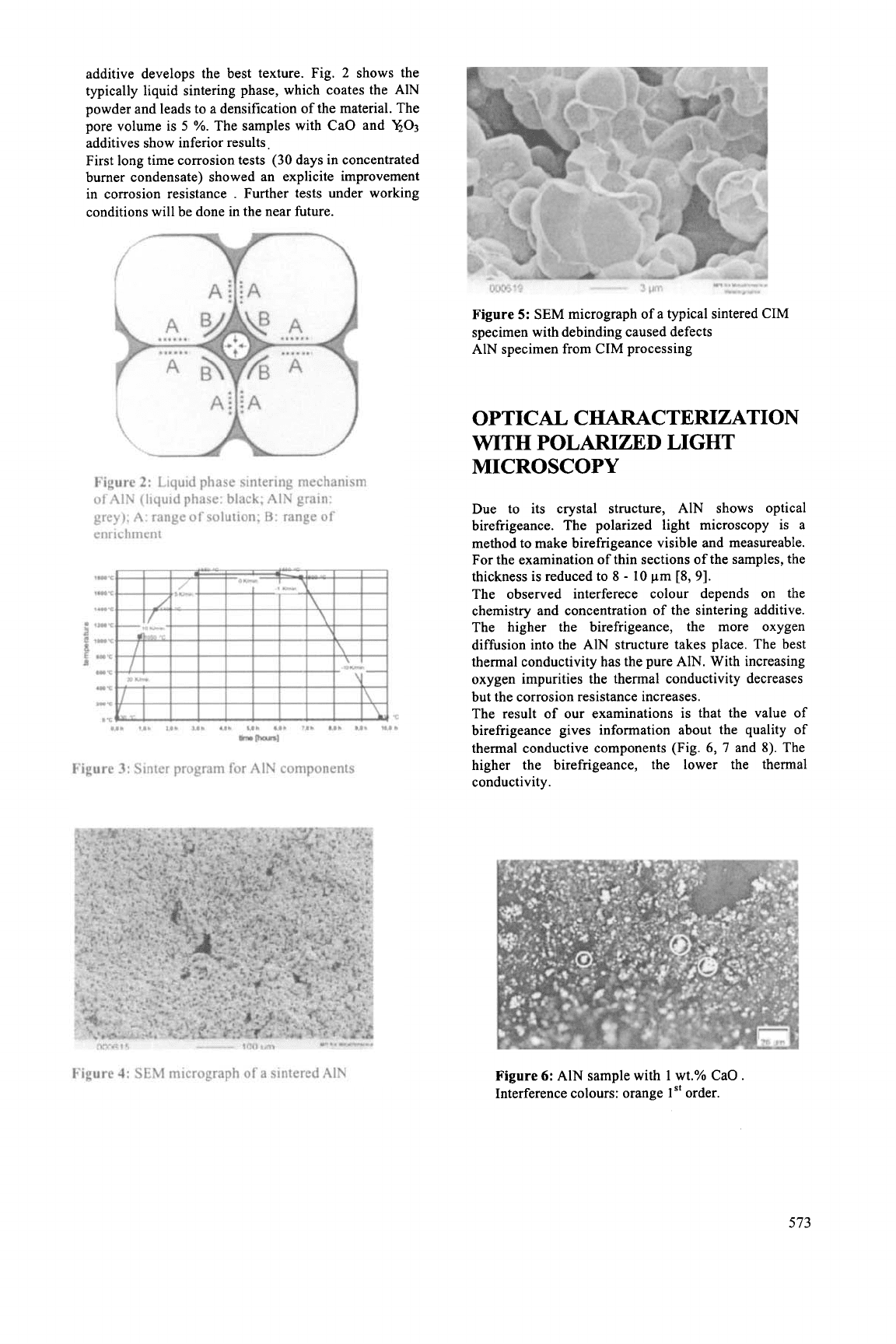
additive develops the best texture. Fig.
2
shows the
typically liquid sintering phase, which coates the AlN
powder and leads to a densification of the material. The
pore volume is
5
%.
The samples with CaO and
YO3
additives show inferior results.
First long time corrosion tests
(30
days in concentrated
burner condensate) showed an explicite improvement
in corrosion resistance
.
Further tests under working
conditions will be done in the near future.
Figure
5:
SEM micrograph of a typical sintered CIM
specimen with debinding caused defects
AlN specimen from CIM processing
OPTICAL CHARACTERIZATION
WITH POLARIZED LIGHT
MICROSCOPY
Figure
2:
Liquid phase sintering mechanism
of A1N (liquid phase: black; AlN grain:
grey); A: range of solution;
B:
range of
enrichment
Due to its crystal structure, AlN shows optical
birefrigeance. The polarized light microscopy is a
method to make birefrigeance visible and measureable.
For
the examination of thin sections
of
the samples, the
thickness is reduced to
8
-
10
pm
[8,
91.
The observed interferece colour depends
on
the
chemistry and concentration of the sintering additive.
The higher the birefrigeance, the more oxygen
diffusion into the AlN structure takes place. The best
thermal conductivity has the pure AlN. With increasing
oxygen impurities the thermal conductivity decreases
but the corrosion resistance increases.
r!!!!!!!!!
r
The result of our examinations is that the value
of
*.Oh
,.Oh
2.0h
,,Oh
.Lh
%Oh
'Lh
ILh
*Oh ,.Oh
ro..n
birefrigeance gives information about the quality
of
thermal conductive components (Fig.
6,
7
and
8).
The
Figure 3:
Sinter program for A1N components higher the birefrigeance, the lower the thermal
conductivity.
mgM1
Figure
4:
SEM micrograph of a sintered AlN
Figure
6:
AlN sample with 1 wt.% CaO
.
Interference colours: orange
1
St
order.
573
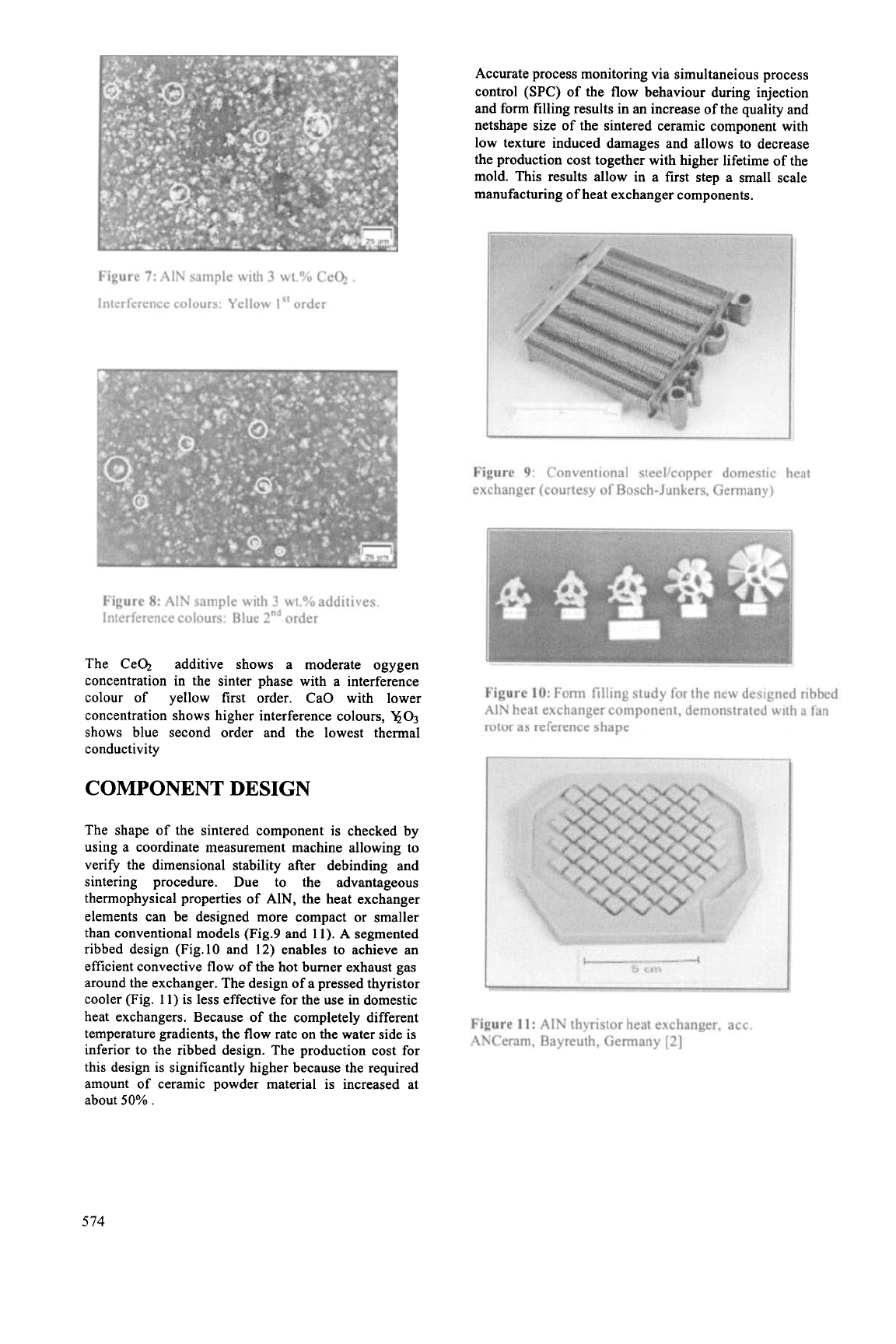
Figure
7:
A1N sample with
3
wt.% CeQ
.
Interference colours: Yellow
1
St
order
Figure
8:
AlN sample with
3
wt.% additives.
Interference colours: Blue
2"d
order
The CeG additive shows a moderate ogygen
concentration in the sinter phase with a interference
colour of yellow first order. CaO with lower
concentration shows higher interference colours,
YO3
shows blue second order and the lowest thermal
conductivity
COMPONENT DESIGN
The shape of the sintered component is checked by
using a coordinate measurement machine allowing to
verify the dimensional stability after debinding and
sintering procedure. Due to the advantageous
thermophysical properties of AlN, the heat exchanger
elements can be designed more compact
or
smaller
than conventional models (Fig.9 and
11).
A segmented
ribbed design (Fig.10 and
12)
enables to achieve an
efficient convective flow of the hot burner exhaust gas
around the exchanger. The design of a pressed thyristor
cooler (Fig.
11)
is less effective for the use in domestic
heat exchangers. Because of the completely different
temperature gradients, the flow rate on the water side is
inferior to the ribbed design. The production cost for
this design is significantly higher because the required
amount of ceramic powder material is increased at
about
50%.
Accurate process monitoring via simultaneious process
control (SPC) of the flow behaviour during injection
and form filling results in
an
increase of the quality and
netshape size
of
the sintered ceramic component with
low texture induced damages and allows to decrease
the production cost together with higher lifetime of the
mold. This results allow in a first step a small scale
manufacturing of heat exchanger components.
Figure
9:
Conventional steel/copper domestic heat
exchanger (courtesy of Bosch-Junkers, Germany)
Figure
10:
Form
filling study for the new designed ribbed
AlN heat exchanger component, demonstrated with a fan
rotor as reference shape
Figure
11:
AlN thyristor heat exchanger, acc.
ANCeram, Bayreuth, Germany
[2]
5
74
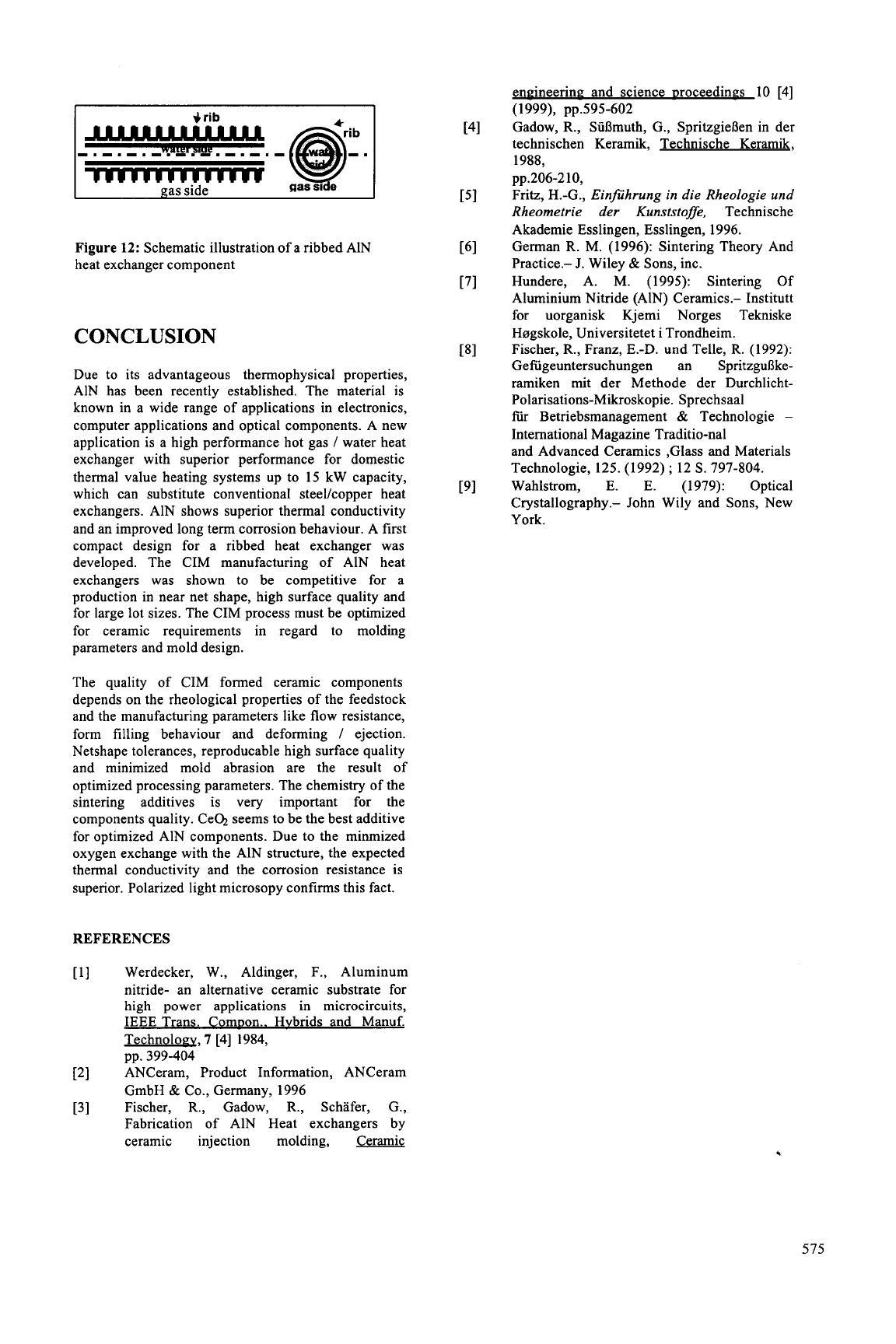
$rib
pas
side
Figure
12:
Schematic illustration of a ribbed A1N
heat exchanger component
CONCLUSION
Due to its advantageous thermophysical properties,
AlN has been recently established. The material is
known in a wide range of applications in electronics,
computer applications and optical components. A new
application is a high performance hot gas
/
water heat
exchanger with superior performance for domestic
thermal value heating systems up to 15 kW capacity,
which can substitute conventional steel/copper heat
exchangers. AlN shows superior thermal conductivity
and an improved long term corrosion behaviour. A first
compact design for a ribbed heat exchanger was
developed. The CIM manufacturing of AlN heat
exchangers was shown to be competitive for a
production in near net shape, high surface quality and
for
large lot sizes. The CIM process must be optimized
for ceramic requirements in regard to molding
parameters and mold design.
The quality of CIM formed ceramic components
depends on the rheological properties of the feedstock
and the manufacturing parameters like flow resistance,
form filling behaviour and deforming
/
ejection.
Netshape tolerances, reproducable high surface quality
and minimized mold abrasion are the result of
optimized processing parameters. The chemistry of the
sintering additives is very important for the
components quality. CeQ seems to be the best additive
for optimized AlN components. Due to the minmized
oxygen exchange with the A1N structure, the expected
thermal conductivity and the corrosion resistance is
superior. Polarized light microsopy confirms this fact.
REFERENCES
[
11 Werdecker, W., Aldinger, F., Aluminum
nitride- an alternative ceramic substrate for
high power applications in microcircuits,
IEEE
Trans. CornDon.. Hvbrids and Manuf.
Technoloey,
7
[4] 1984,
pp. 399-404
[2] ANCeram, Product Information, ANCeram
GmbH
&
Co., Germany, 1996
[3] Fischer,
R.,
Gadow,
R.,
Schafer, G.,
Fabrication of AlN Heat exchangers by
ceramic injection molding, Ceramiq
engineering and science Droceedines
10
[4]
Gadow,
R.,
SuBmuth, G., SpritzgieBen in der
technischen Keramik, Technische Keramik,
1988,
Fritz, H.-G.,
Einfuhrung
in
die Rheologie und
Rheometrie der Kunststofle,
Technische
Akademie Esslingen, Esslingen, 1996.
[6] German
R.
M. (1996): Sintering Theory And
Practice.-
J.
Wiley
&
Sons, inc.
[7] Hundere, A. M. (1995): Sintering Of
Aluminium Nitride (AlN) Ceramics.- Institutt
for uorganisk Kjemi Norges Tekniske
Hargskole, Universitetet i Trondheim.
Fischer,
R.,
Franz, E.-D. und Telle,
R.
(1992):
Gefigeuntersuchungen an SpritzguRke-
ramiken mit der Methode der Durchlicht-
Polarisations-Mikroskopie.
Sprechsaal
fir
Betriebsmanagement
&
Technologie
-
International Magazine Traditio-nal
and Advanced Ceramics ,Glass and Materials
Technologie, 125. (1992)
;
12
S.
797-804.
[9] Wahlstrom,
E.
E.
(1979): Optical
Crystallography.- John Wily and Sons, New
York.
(1999), pp.595-602
[4]
pp.206-2
10,
[5]
[8]
575

This Page Intentionally Left Blank
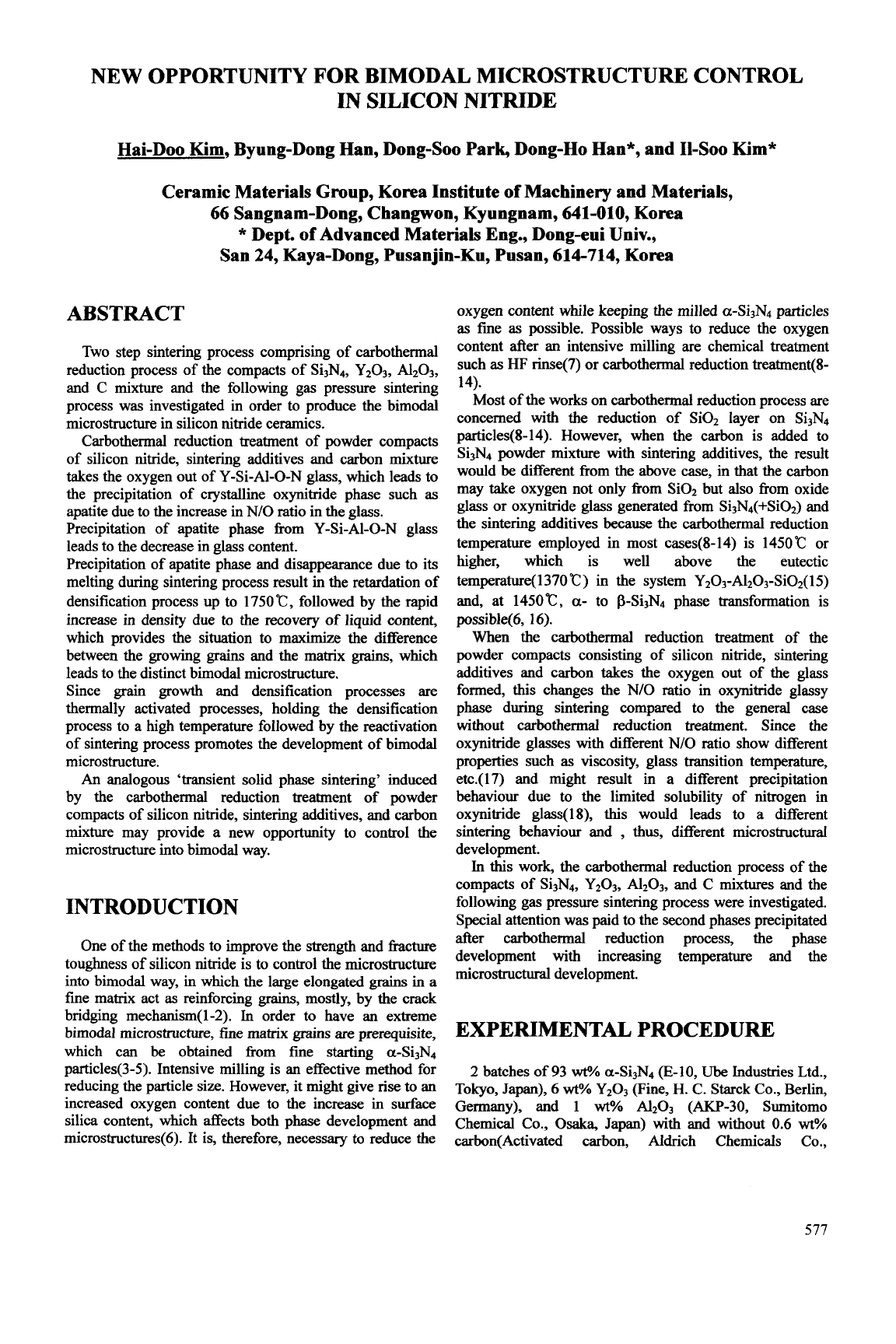
NEW OPPORTUNITY FOR BIMODAL MICROSTRUCTURE CONTROL
IN SILICON NITRIDE
Hai-Doo Kim, Byung-Dong Han, Dong-Soo Park, Dong-Ho Han*, and 11-So0 Kim*
Ceramic Materials Group, Korea Institute
of
Machinery and Materials,
66 Sangnam-Dong, Changwon, Kyungnam, 641-010, Korea
*
Dept.
of
Advanced Materials
Eng.,
Dong-eui Univ.,
San 24, Kaya-Dong, Pusanjin-Ku, Pusan, 614-714, Korea
ABSTRACT
Two step sintering process comprising of carbothermal
reduction process of the compacts of Si3N4, Y2O3, A1203,
and C mixture and the following gas pressure sintering
process was investigated in order to produce the bimodal
microstructure in silicon nitride ceramics.
Carbothermal reduction treatment of powder compacts
of silicon nitride, sintering additives and carbon
mixture
takes the oxygen out of Y-Si-Al-0-N glass, which leads to
the precipitation of crystalline oxynitride phase such
as
apatite due to the increase in
N/O
ratio in the glass.
Precipitation of apatite phase from Y-Si-A1-0-N glass
leads to the decrease in glass content.
Precipitation of apatite phase and disappearance due to its
melting during sintering process result in the retardation of
densification process up to 1750
“c
,
followed by the rapid
increase in density due to the recovery
of
liquid content,
which provides the situation to maximize the difference
between the growing grains and the matrix
grains,
which
leads to the distinct bimodal microstructure.
Since grain growth and densification processes are
thermally activated processes, holding the densification
process to a high temperature followed by the reactivation
of sintering process promotes the development of bimodal
microstructure.
An
analogous ‘transient solid phase sintering’ induced
by the carbothermal reduction treatment of powder
compacts of silicon nitride, sintering additives, and carbon
mixture may provide a new opportunity to control the
microstructure into bimodal way.
INTRODUCTION
One of the methods to improve the strength and
hture
toughness of silicon nitride is to control the microstructure
into bimodal way, in which the large elongated
grains
in a
fine matrix act
as
reinforcing grains, mostly, by the crack
bridging mechanism(1-2). In order to have an extreme
bimodal microstructure,
fine
matrix
grains
are prerequisite,
which can be obtained from fine starting a-Si3N4
particles(3-5). Intensive milling is an effective method for
reducing the particle size. However, it might give
rise
to an
increased oxygen content due to the increase in surface
silica content, which affects both phase development and
microstructures(6). It is, therefore, necessary to reduce the
oxygen content while keeping the milled a-Si3N4 particles
as
fine
as
possible. Possible ways to reduce the oxygen
content after an intensive milling are chemical treatment
such
as
HF rinse(7) or carbothermal reduction treatment(&
14).
Most of the works on carbothermal reduction process are
concerned with the reduction of SiOz layer on Si3N4
particles(8-14). However, when the carbon is added to
Si3N4 powder mixture with sintering additives, the result
would be different from the above case, in that the carbon
may take oxygen not only from Si02 but also fiom oxide
glass or oxynitride glass generated from Si3N4(+Si02) and
the sintering additives because the carbothermal reduction
temperature employed in most cases(8-14) is 1450°C or
higher, which is well above the eutectic
temperature( 1370
C
)
in the system Y203-A1203-Si02( 15)
and, at 1450C,
a-
to p-Si3N4 phase transformation is
possible(6, 16).
When
the carbothermal reduction treatment of the
powder compacts consisting of silicon nitride, sintering
additives and carbon takes the oxygen out of the glass
formed,
this
changes the N/O ratio in oxynitride glassy
phase during sintering compared to the general case
without carbothermal reduction treatment. Since the
oxynitride
glasses
with different
N/O
ratio show different
properties such
as
viscosity, glass transition temperature,
etc.(l7) and might result in a different precipitation
behaviour due to the limited solubility of nitrogen in
oxynitride glass(l8),
this
would leads to a different
sintering behaviour and
,
thus, different microstructural
development.
In
this
work, the carbothermal reduction process of the
compacts of Si3N4, Y2O3, Al2O3, and C mixtures and the
following gas pressure sintering process were investigated.
Special attention was paid to the second phases precipitated
after carbothermal reduction process, the phase
development with increasing temperature and the
microstructural development.
EXPERIMENTAL PROCEDURE
2
batches of
93
wt?!
a-Si3N4
(E-10,
Ube
Industries Ltd.,
Tokyo,
Japan),
6
wt%
Y203 (Fine, H. C. Starck Co., Berlin,
Germany), and 1
wt%
A1203
(AKP-30,
Sumitomo
Chemical Co.,
Osaka,
Japan) with and without 0.6
wt%
carbon(Activated carbon, Aldrich Chemicals Co.,
577
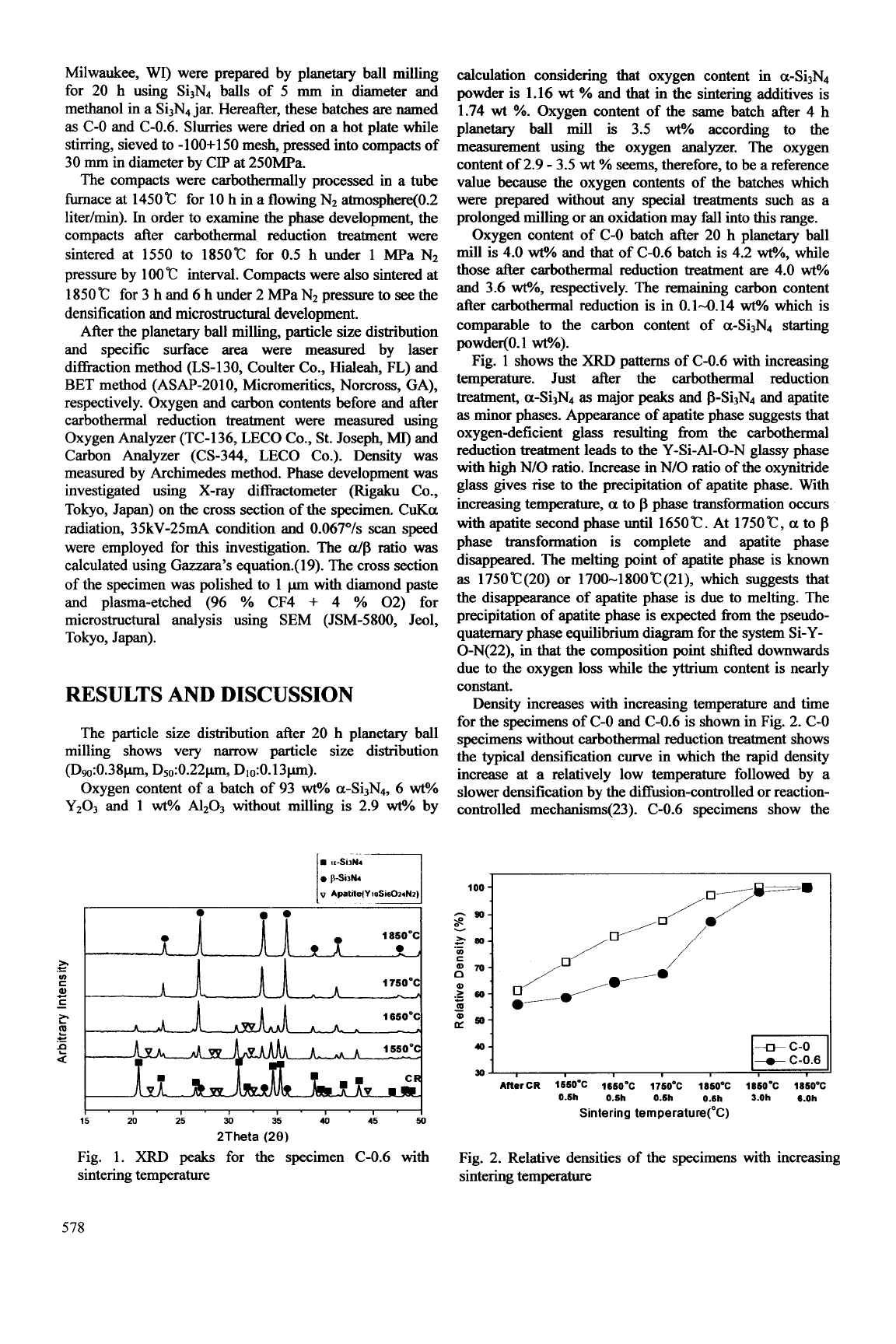
Milwaukee,
WI)
were prepared by planetary ball milling
for 20 h using Si3N4 balls of
5
mm
in diameter and
methanol in a Si3N4 jar. Hereafter, these batches
are
named
as
C-0 and C-0.6. Slurries were dried on a hot plate while
stirring, sieved to -100+150 mesh, pressed into compacts of
30
mm
in diameter by CIP at 250MPa
The compacts were carbothermally processed in a tube
furnace at 1450°C for 10 h in a flowing N2 atmosphere(0.2
literlmin). In order to examine the phase development, the
compacts after carbothermal reduction treatment were
sintered at 1550 to 1850°C for
0.5
h under 1 MPa N2
pressure by 100°C interval. Compacts were
also
sintered at
1850°C for 3 h and 6 h under 2 MPaN2 pressure to see the
densification and microstructural development.
After the planetary ball milling, particle size distribution
and specific surface area were measured by laser
diffraction method (LS-130, Coulter Co., Hialeah, FL) and
BET method (ASAP-201
0,
Micromeritics, Norcross, GA),
respectively. Oxygen and carbon contents before and after
carbothermal reduction treatment were measured using
Oxygen Analyzer (TC-136, LECO Co., St. Joseph, MI) and
Carbon Analyzer (CS-344, LECO Co.). Density was
measured by Archimedes method.
Phase
development was
investigated using X-ray dihtometer (Rigaku Co.,
Tokyo, Japan) on the cross section of the specimen. CuKa
radiation, 35kV-25mA condition and O.O67O/s scan speed
were employed for
this
investigation. The
dp
ratio was
calculated using Gazzara's equation.( 19). The cross section
of the specimen was polished to
1
pn
with diamond paste
and plasma-etched (96
%
CF4
+
4
%
02) for
microstructural analysis using SEM (JSM-5800, Jeol,
Tokyo, Japan).
4-
RESULTS
AND DISCUSSION
calculation considering that oxygen content in a-Si3N4
powder
is
1.16
wt
Yo
and that in the sintering additives is
1.74
wt
%.
Oxygen content of the same batch after 4 h
planetiuy ball mill
is
3.5
wt%
according to the
measurement using the oxygen analyzer. The oxygen
content of 2.9
-
3.5
wt
%
seems,
therefore, to be a reference
value because the oxygen contents of the batches which
were prepared without any special treatments such
as
a
prolonged milling or an oxidation may fall into
this
range.
Oxygen content of C-0 batch after 20 h planetary ball
mill
is
4.0
wt%
and that of C-0.6 batch is 4.2
wt%,
while
those
after
carbothermal reduction treatment
are
4.0
wt%
and 3.6
wt%,
respectively. The remaining carbon content
after carbothermal reduction is in 0.1-0.14
wt%
which is
comparable to the carbon content of a-Si3N4 starting
powder(O.1
wt%).
Fig. 1 shows the
XRD
patterns of C-0.6 with increasing
temperature. Just after the carbothermal reduction
treatment, a-Si3N4
as
major peaks and p-Si3N4 and apatite
as
minor phases. Appearance of apatite phase suggests that
oxygen-deficient glass resulting from the carbothermal
reduction treatment leads to the Y-Si-Al-0-N glassy phase
with high N/O ratio. Increase in N10 ratio of the oxynitride
glass
gives rise to the precipitation of apatite phase. With
increasing temperature,
a
to
p
phase transformation occurs
with apatite second phase until 1650°C. At 1750"C,
a
to
p
phase transformation is complete and apatite phase
disappeared. The melting point of apatite phase is known
as
1750"C(20) or 1700-1800"C(21), which suggests that
the disappearance of apatite phase is due to melting. The
precipitation of apatite phase is expected from the pseudo-
quaternary phase equilibrium diagram for the system Si-Y-
0-N(22), in that the composition point shifted downwards
due to the oxygen loss while the yttrium content is nearly
constant.
Density increases with increasing temperature and time
for the specimens of C-0 and C-Odis shown in Fig. 2. C-0
specimens without carboth-al reduction
treatment
shows
the typical densification
curve
in
which the rapid density
increase
at
a relatively low temperature followed by a
slower densification by the diffusion-controlled or reaction-
controlled mechanisms(23). C-0.6 specimens show the
The particle size distribution after 20 h planetary ball
milling shows very narrow particle size distribution
(D~:0.38~, D50:0.22p, Dlo:O.13p).
6
wt%
y203
and 1
wt%
A203
without milling is 2-9
&?
bY
Oxygen Content of a batch of 93
wt%
x
r
m
c
P)
=
0
0
l85O0C
91
0,
A
hh.A
1750°C
n
L
-
2
1650'
?J
A.
A
.
-
I.,.I.,.,.,.I.I
2Theta (28)
Fig. 1.
XRD
peaks for the specimen C-0.6 with
sintering temperature
15
20
25
30
35
40
45
50
Fig. 2. Relative densities of the specimens with increasing
sintering temperature
578
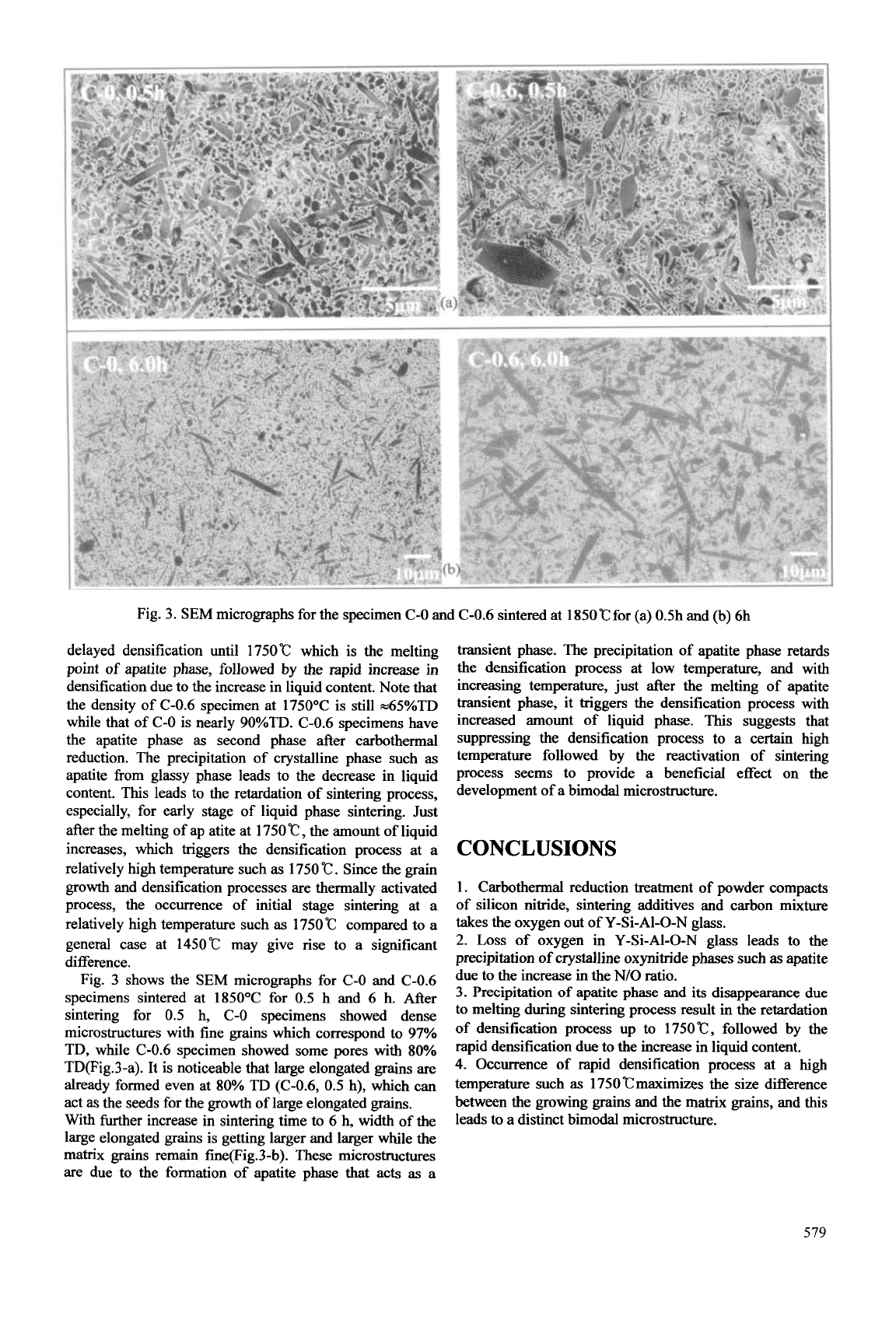
Fig. 3.
SEM
micrographs for the specimen C-0 and C-0.6 sintered at 1850“Cfor (a) 0.5h and (b) 6h
delayed densification until 1750°C which is the melting
point of apatite phase, followed by the rapid increase in
densification due to the increase in liquid content. Note that
the density of C-0.6 specimen at 1750°C is still &5%TD
while that of C-0 is nearly 90%TD. C-0.6 specimens have
the apatite phase
as
second phase after carbothermal
reduction. The precipitation of crystalline phase such
as
apatite from glassy phase leads to the decrease in liquid
content. This leads to the retardation of sintering process,
especially, for early stage of liquid phase sintering. Just
after the melting of ap atite at 1750
“c,
the amount of liquid
increases, which triggers the densification process at a
relatively high temperature such
as
1750
“c
.
Since the grain
growth and densification processes are thermally activated
process, the occurrence of initial stage sintering at a
relatively high temperature such
as
1750°C compared to a
general case at 1450°C may give rise to a significant
difference.
Fig. 3 shows the
SEM
micrographs for C-0 and C-0.6
specimens sintered at 1850°C for
0.5
h and 6 h. After
sintering for 0.5 h, C-0 specimens showed dense
microstructures with fine grains which correspond to 97%
TD, while (2-0.6 specimen showed some pores with
80%
TD(Fig.3-a). It
is
noticeable that large elongated grains
are
already formed even at
80%
TD
(C-0.6,
0.5
h), which can
act
as
the seeds for the growth of large elongated grains.
With further increase in sintering time to 6 h, width of the
large elongated grains is getting larger and larger while the
matrix grains remain fine(Fig.3-b). These microstructures
are due to the formation of apatite phase that acts
as
a
transient phase. The precipitation of apatite phase retards
the densification process at low temperature, and with
increasing temperature, just after the melting of apatite
transient phase, it triggers the densification process with
increased amount of liquid phase.
This
suggests that
suppressing the densification process to a certain high
temperature followed by the reactivation of sintering
process seems to provide a beneficial effect on the
development of a bimodal microstructure.
CONCLUSIONS
1. Carbothermal reduction treatment
of
powder compacts
of silicon nitride, sintering additives and carbon mixture
takes the oxygen out of Y-Si-Al-0-N glass.
2.
Loss
of oxygen in Y-Si-Al-0-N glass leads to the
precipitation of crystalline oxynitride phases such
as
apatite
due to the increase in the
N/O
ratio.
3.
Precipitation
of
apatite phase and its disappearance due
to melting during sintering process result in the retardation
of densification process up to 1750“C, followed by the
rapid densification due to the increase in liquid content.
4. Occurrence of rapid densification process at a high
temperature such
as
1750
“C
maximizes the size difference
between the growing grains and the matrix grains, and
this
leads to a distinct bimodal microstructure.
579
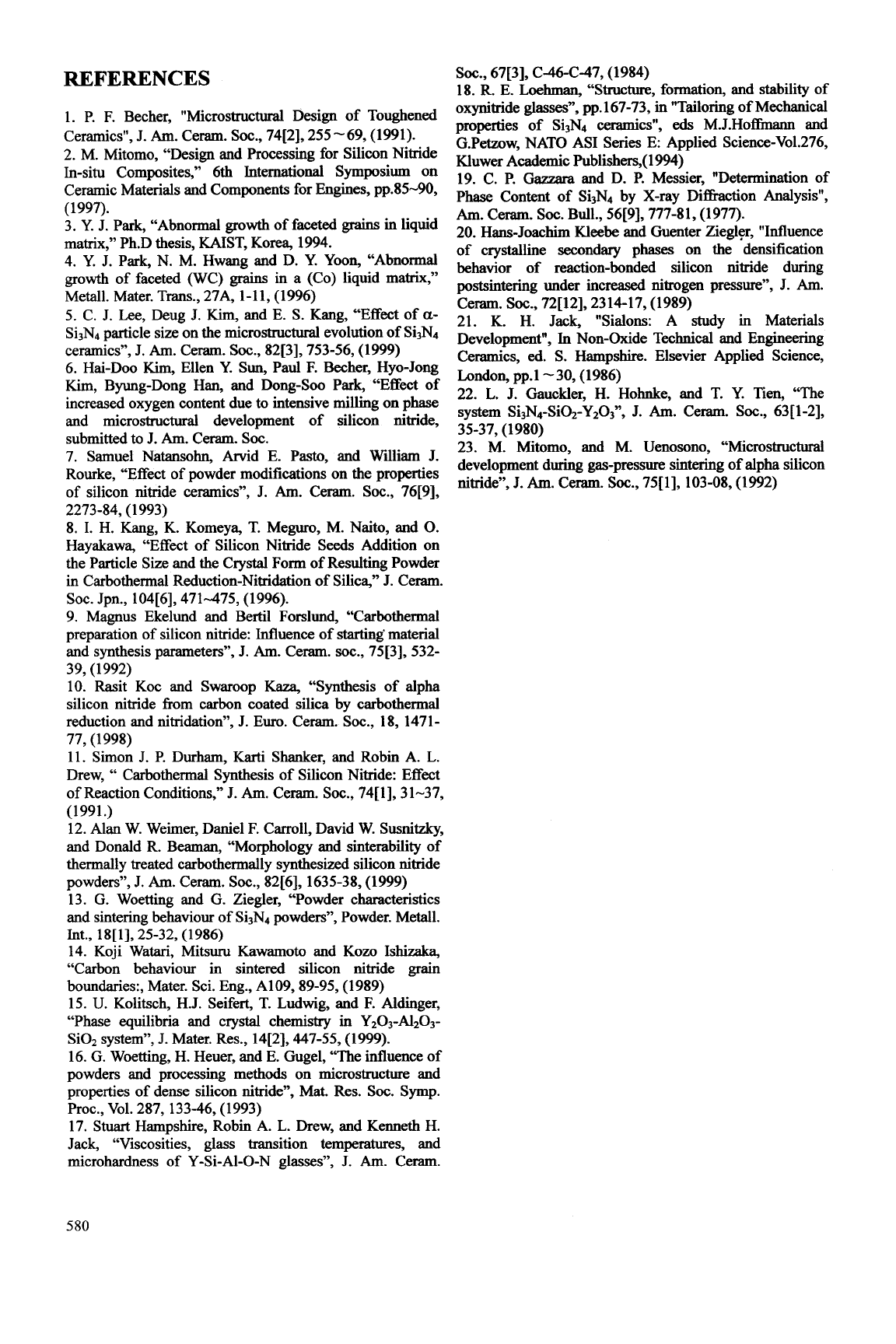
REFERENCES
SOC.,
67[3],
(2-46-C-47,
(1984)
18.
R. E. Loehman.
“Structure,
formation, and stability of
oxynitride gla~ses”,~pp.
167-73,&
“Tailoring of MecGcal
properties of Si3N4 ceramics”,
eds
M.J.Hof3ka.m and
G.petzow, NATO As1
E:
the lied
science-v01.276,
Kluwer
Academic
~blishers,(1994)
phase
content
of
si3N4
by
x-ray
1.
P. F. Becher, “Microstructural Design of Toughened
Ceramics”,
J.
Am.
Ceram.
Sw-,
W2L255-69, (1991)-
2.
M. Mitomo, “Design and Processing for Silicon Nitride
Ceramic Materials and Components for Engines,
pp.85-90,
h-situ composites,”
6th
International spposium
On
(1997).
19.
C.
p.
Gn ad D. P. Messier, “Determination of
halysis~~,
Am.
C-.
SOC.
Bull.,
56[9], 777-81, (1977).
3.
Y- J. Park, “Ab~Ormal
growth
Of
faceted
grainS
in
liquid
20.
~ans-Joachim
KlWbe
and GWnter Zieglp, “Influence
matrix,” Ph.D thesis,
KAIST,
Korea,
1994.
of crystallie secondary phases on the densification
growth
of faceted (WC)
grains
in a (Co) liquid matrix,”
postsinkhg
increased
pressure79,
J.
Am.
Metall. Mater. Trans.,
27A,
1-11,
(1996)
Si3N4 particle size on the microstructural evolution of Si3N4
ceramics”, J.
Am.
Ceram.
Soc.,
82[3], 753-56, (1999)
6.
Hai-Doo
Kim,
Ellen
Y.
Sun, Paul F. Becher, Hyo-Jong
Kim, Byung-Dong Han, and Dong-Soo Park, “Effect of
increased oxygen content due to intensive milling on phase
and microstructural development of silicon nitride,
submitted to J.
Am.
Ceram. SOC.
Rourke, “Effect of powder modifications on the properties
of
silicon nitride ceramics”, J.
Am.
Ceram.
Soc.,
76[9],
4.
Y.
J.
Park, N. M. Hwang and D. Y.
YOO&
“Abnormal
behavior
of
redon-bonded silicon
during
Ceram.
SOC.,
72[12], 2314-17, (1989)
Developmentlt,
In
Non-mde and Engineering
Ceramics,
ed.
S.
Hampshire. Elsevier Applied Science,
London,
pp.l
-30,
(1986)
22.
L.
J.
Gauckler, H. Hohnke, and T.
Y.
Tien, “The
system Si3N4-SiO2-Yz0T, J.
Am.
Ceram.
Soc.,
63[1-21,
23.
M. Mitomo, and M. Uenosono, “Microstructural
nitride”, J.
Am.
Ceram.
Soc.,
75[1], 103-08, (1992)
5.
C. J. Lee, Deug J.
Kim,
and E.
S.
Kang, “Effect
Of
a-
21.
K.
H.
nsialOns:
A
study in ~~terial~
35-37, (1980)
7*
Natansohn,
E-
’-9
and
J‘
development during
gas-pressure
sineg
of
alpha
~~
2273-84, (1 993)
8.
I.
H. Kang, K. Komeya, T. Megum, M. Naito, and
0.
Hayakawa, “Effect of Silicon Nitride
Seeds
Addition on
the Particle Size and the Crystal Form of Resulting Powder
in Carbothermal Reduction-Nitridation of Silica,” J. Ceram.
SOC. Jpn.,
104[6], 471475, (1996).
9.
Magnus Ekelund and Bertil Forslund, “Carbothermal
preparation of silicon nitride: Influence of
starting’
material
and synthesis parameters”, J.
Am.
Ceram. soc.,
75[3], 532-
39, (1 992)
10.
Rasit Koc and Swaroop
Kaza,
“Synthesis of alpha
silicon nitride from carbon coated silica by carbothermal
reduction and nitridation”, J. Em. Ceram.
Soc.,
18, 1471-
77,
(1
998)
11.
Simon J. P. Durham, Karti Shanker, and Robin A. L.
Drew,
‘‘
Carbothermal Synthesis of Silicon Nitride: Effect
of Reaction Conditions,” J.
Am.
Ceram.
Soc.,
74[1], 31-37,
(1 991
.)
12.
Alan W. Weimer, Daniel F. Carroll, David W.
Susnitzky,
and Donald R. Beaman, “Morphology and sinterability of
thermally treated carbothemally synthesized silicon nitride
powders”, J.
Am.
Ceram.
Soc.,
82[6], 1635-38, (1999)
13.
G.
Woetting and G. Ziegler, “Powder characteristics
and sintering behaviour of Si3N4 powders”, Powder. Metall.
14.
Koji Watari, Mitsuru Kawamoto and
Kozo
Ishizaka,
“Carbon behaviour in sintered silicon nitride
grain
boundaries:, Mater. Sci. Eng.,
A109,89-95, (1989)
15.
U.
Kolitsch, H.J. Seifert, T. Ludwig, and
F.
Aldinger,
“Phase equilibria and crystal chemistry in
Y203-A1203-
SiOz system”,
J.
Mater. Res.,
14[2], 447-55, (1999).
16.
G. Woetting, H. Heuer, and E. Gugel, “The influence of
powders and processing methods
on
microstructure and
properties of dense silicon nitride”, Mat. Res.
Soc.
Symp.
Proc., Vol.
287, 133-46, (1993)
17.
Stuart Hampshire, Robin A. L. Drew, and Kenneth H.
Jack, ccViscosities, glass transition temperatures, and
microhardness of Y-Si-Al-0-N
glasses”,
J.
Am.
Ceram.
Int.,
18[1],
25-32, (1986)
580
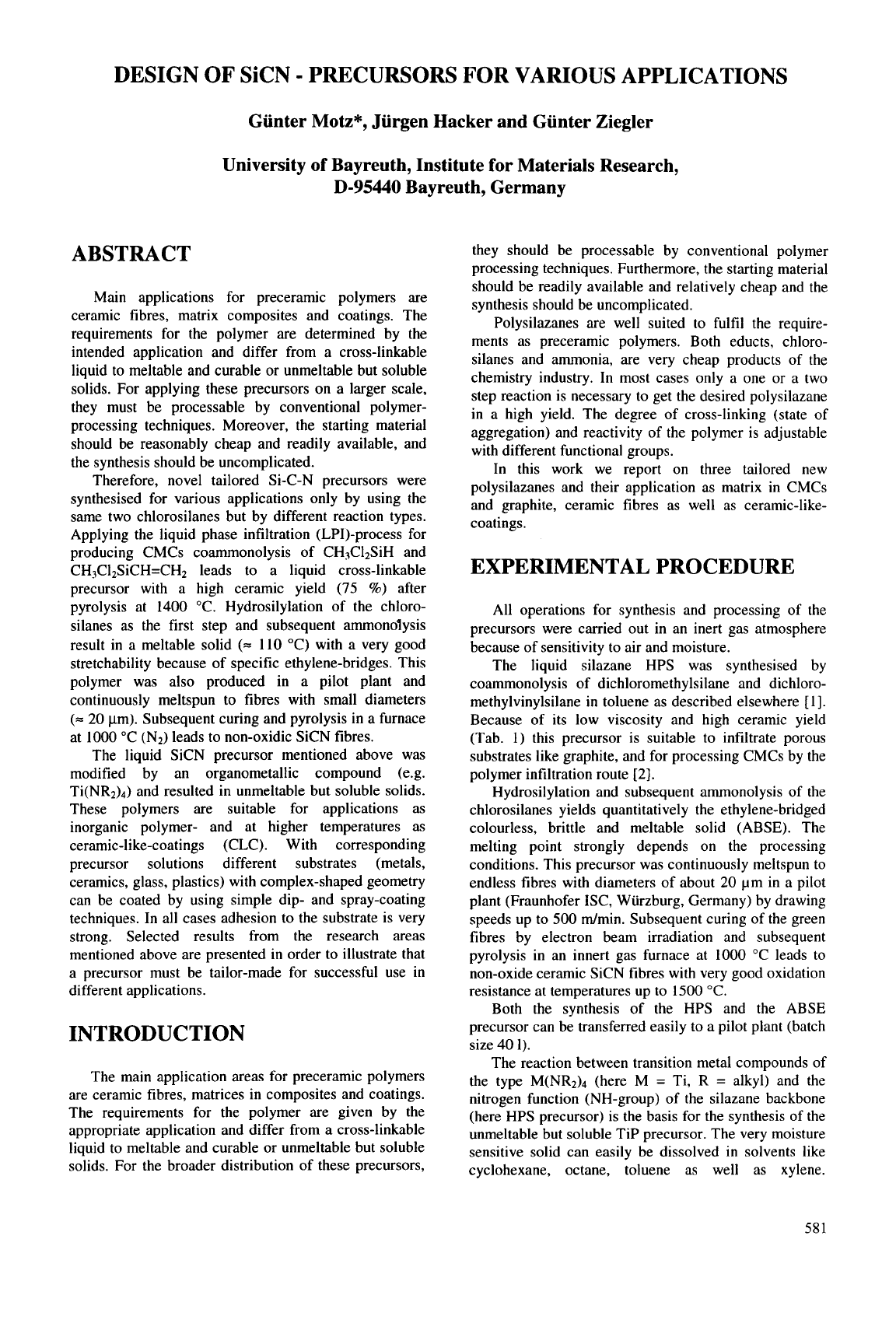
DESIGN OF SiCN
-
PRECURSORS FOR VARIOUS APPLICATIONS
Gunter Motz*, Jurgen Hacker and Gunter Ziegler
University
of
Bayreuth, Institute for Materials Research,
D-95440
Bayreuth, Germany
ABSTRACT
Main applications for preceramic polymers are
ceramic fibres, matrix composites and coatings. The
requirements for the polymer are determined by the
intended application and differ from
a cross-linkable
liquid to meltable and curable or unmeltable but soluble
solids.
For
applying these precursors on a larger scale,
they must be processable by conventional polymer-
processing techniques. Moreover, the starting material
should be reasonably cheap and readily available, and
the synthesis should be uncomplicated.
Therefore, novel tailored Si-C-N precursors were
synthesised for various applications only by using the
same two chlorosilanes but by different reaction types.
Applying the liquid phase infiltration (LP1)-process for
producing CMCs coammonolysis of CH3C12SiH and
CH3C12SiCH=CH2 leads to
a
liquid cross-linkable
precursor with
a
high ceramic yield
(75
%)
after
pyrolysis at 1400 "C. Hydrosilylation of the chloro-
silanes
as
the first step and subsequent ammonolysis
result
in
a
meltable solid
(=
110 "C) with a very good
stretchability because of specific ethylene-bridges. This
polymer was also produced in
a
pilot plant and
continuously meltspun to fibres with small diameters
(=
20 pm). Subsequent curing and pyrolysis in a furnace
at
1000
"C (N2) leads to non-oxidic SiCN fibres.
The liquid SiCN precursor mentioned above was
modified by an organometallic compound (e.g.
Ti(NR2)4) and resulted in unmeltable but soluble solids.
These polymers are suitable
for
applications
as
inorganic polymer- and at higher temperatures
as
ceramic-like-coatings (CLC). With corresponding
precursor solutions different substrates (metals,
ceramics, glass, plastics) with complex-shaped geometry
can be coated by using simple dip- and spray-coating
techniques. In all cases adhesion to the substrate is very
strong. Selected results from the research areas
mentioned above are presented
in
order to illustrate that
a
precursor must be tailor-made for successful use
in
different applications.
INTRODUCTION
The main application areas for preceramic polymers
are ceramic fibres, matrices
in
composites and coatings.
The requirements for the polymer are given by the
appropriate application and differ from
a
cross-linkable
liquid to meltable and curable
or
unmeltable but soluble
solids.
For the broader distribution of these precursors,
they should be processable by conventional polymer
processing techniques. Furthermore, the starting material
should be readily available and relatively cheap and the
synthesis should be uncomplicated.
Polysilazanes are well suited to fulfil the require-
ments
as
preceramic polymers. Both educts, chloro-
silanes and ammonia, are very cheap products
of
the
chemistry industry.
In
most cases only
a
one
or
a
two
step reaction is necessary to get the desired polysilazane
in
a
high yield. The degree
of
cross-linking (state of
aggregation) and reactivity of the polymer is adjustable
with different functional groups.
In this work we report on three tailored new
polysilazanes and their application
as
matrix in CMCs
and graphite, ceramic fibres as well as ceramic-like-
coatings.
EXPERIMENTAL PROCEDURE
All operations for synthesis and processing of the
precursors were carried out in an inert gas atmosphere
because of sensitivity to air and moisture.
The liquid silazane HPS was synthesised by
coammonolysis of dichloromethylsilane and dichloro-
methylvinylsilane
in
toluene
as
described elsewhere
[I].
Because of its low viscosity and high ceramic yield
(Tab.
1)
this precursor is suitable to infiltrate porous
substrates like graphite, and for processing CMCs by the
polymer infiltration route
121.
Hydrosilylation and subsequent ammonolysis of the
chlorosilanes yields quantitatively the ethylene-bridged
colourless, brittle and meltable solid (ABSE). The
melting point strongly depends on the processing
conditions. This precursor was continuously meltspun to
endless fibres with diameters of about
20
ym
in
a
pilot
plant (Fraunhofer ISC, Wiirzburg, Germany) by drawing
speeds up to
500
dmin. Subsequent curing of the green
fibres by electron beam irradiation and subsequent
pyrolysis
in
an innert gas furnace at
1000
"C leads to
non-oxide ceramic SiCN fibres with very good oxidation
resistance at temperatures up
to
1500
"C.
Both the synthesis of the HPS and the ABSE
precursor can be transferred easily to
a
pilot plant (batch
size 40
1).
The reaction between transition metal compounds of
the type M(NR2)4 (here M
=
Ti,
R
=
alkyl) and the
nitrogen function (NH-group) of the silazane backbone
(here HPS precursor) is the basis for the synthesis of the
unmeltable but soluble TIP precursor. The very moisture
sensitive solid can easily be dissolved
in
solvents like
cyclohexane, octane, toluene
as
well as xylene.
581
